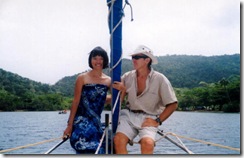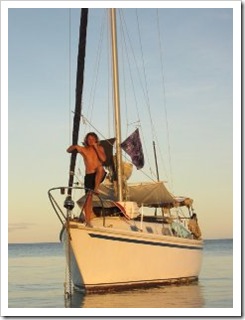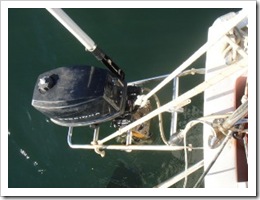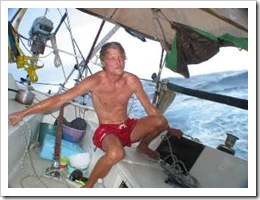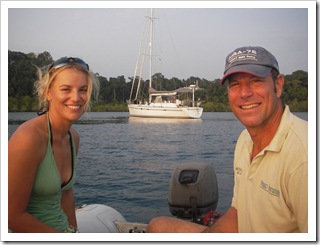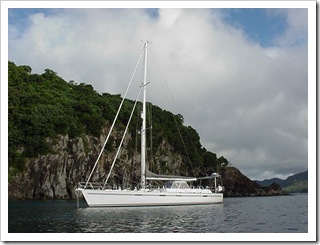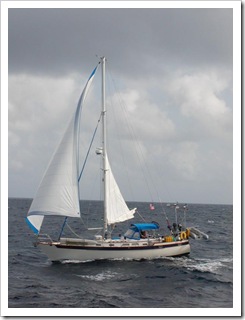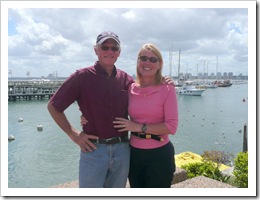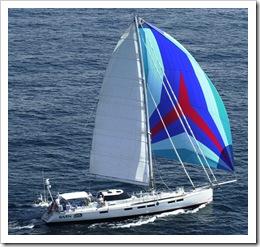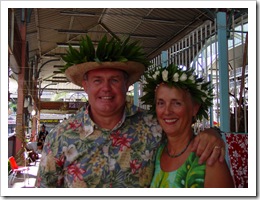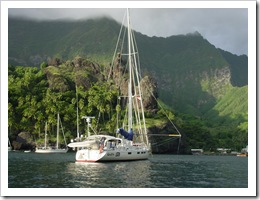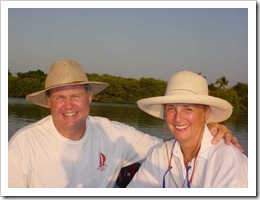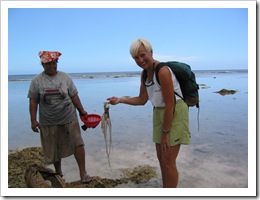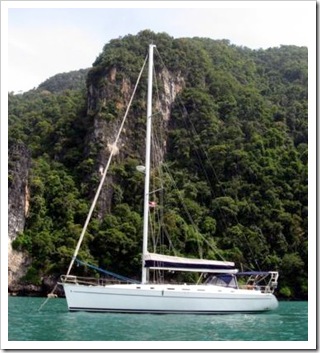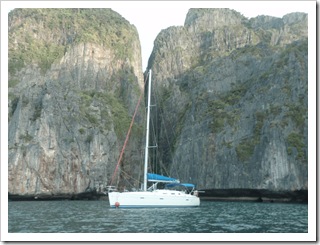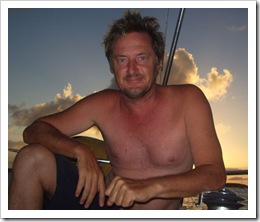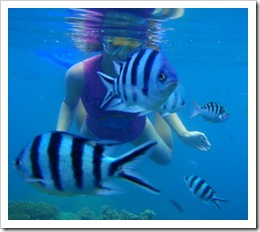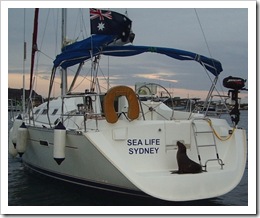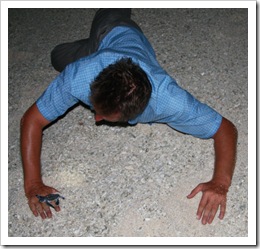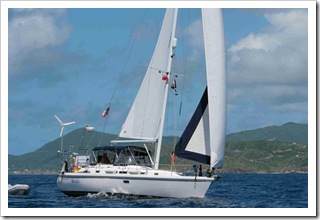 MoonSail is a Catalina/Morgan Center-cockpit 38 hailing from Kemah, TX, USA. Chris Mooney (Captain) and Barbara Leachman (self-titled 1st mate/galley slave) cruised aboard MoonSail from 2005 - 2009 through the Caribbean, Bahamas and US East Coast. They returned for a few years of work and hope to resume cruising in Fall 2011. You can find more details on their website or send an email (Barb@moonsail.com). Barb says: Cruising was not my idea nor was it my dream but I am now hooked and love the lifestyle. I moved on to the boat from a 2000 sq ft house with 2 suit cases. I had no problem selling my house and just about everything I owned. I was ready to leave the corporate life and go on an adventure. I am extremely lucky to have found a very accommodating and easy going mate to teach me and learn with me the life of a cruiser.
MoonSail is a Catalina/Morgan Center-cockpit 38 hailing from Kemah, TX, USA. Chris Mooney (Captain) and Barbara Leachman (self-titled 1st mate/galley slave) cruised aboard MoonSail from 2005 - 2009 through the Caribbean, Bahamas and US East Coast. They returned for a few years of work and hope to resume cruising in Fall 2011. You can find more details on their website or send an email (Barb@moonsail.com). Barb says: Cruising was not my idea nor was it my dream but I am now hooked and love the lifestyle. I moved on to the boat from a 2000 sq ft house with 2 suit cases. I had no problem selling my house and just about everything I owned. I was ready to leave the corporate life and go on an adventure. I am extremely lucky to have found a very accommodating and easy going mate to teach me and learn with me the life of a cruiser.What (if anything) do you wish someone had told you before you started cruising?
Chris: How much we would motor-sail. For a 38 foot sailboat to go from island to island during daylight
hours, you almost always have to run the rhumb line. There is no time for tacking and using the wind. A 45 foot or larger boat goes fast enough to sail it.
Barbara: I can’t think of anything specific that I wished someone told me before we left. It was a lot of fun learning from other cruisers as we went. They are all such fun loving can caring people. A lot of people asked if I was scared and thought there were pirates everywhere. I was nervous but I can honestly say I was only scared a couple of times and that had nothing to do with pirates.
What is something that you read or heard about cruising, that you found particularly accurate?
Chris: That security in the Caribbean (as far south as Grenada), for the most part, is not an issue. The constant worry about security is overblown. Common sense and practical precautions will keep you out of trouble. Trinidad & Venezuela are a whole other story and in my opinion to be avoided.
Barbara: The most accurate statement I would say we found to be true was that all plans are cast in Jell-o or sand.
What was the most affordable area you have cruised and the most expensive? What was affordable or expensive about each area?
Chris: Northeast US was most expensive. $40-60/night for a mooring. Crowded during the summer, especially weekends, since the local boaters have a short season to play in. Caribbean was not cheap, but could be done reasonably. Food, especially US style food is expensive, as was electricity at the docks, rum & beer are cheap. Plenty of ability to anchor as much as you want to save dockage costs.
Barbara: The cheapest area was the Dominican Republic, but it was also the poorest country. I was not comfortable in that country and have no desire to return. The Dominican Republic is a beautiful country, but the officials are very corrupt. The sanitary conditions left a lot to be desired and you have to continually use hand sanitizer after touching anything that was in the water you are anchored in.
I would say Grenada was very affordable and easy to live in. Grenada is affordable in for both marine services and goods. They have one of the best open air markets in the Caribbean. The people are still so thankful to the Americans for aiding them in the conflict in the 80’s that they will come up to you and shake your hand and say thank you to your face.
The most expensive area was Martha’s Vineyard/Nantucket/long island sound area. The Northeast of the US around Long Island sound and NYC is the most expensive place we went. The mooring balls were $60 per night and that didn’t include launch service to shore. In many areas that was an additional $10-15 per person 1 way. The area is beautiful though and we are very glad we spent time in the area.
I n your own experience and your experience meeting cruising couples, can you convince a reluctant partner to go cruising and if so, how?
Chris: I think usually not well. In our case, the dream was mine and Barb got drawn into it. I had the plan when we met.
 She had never sailed before. She jumped in whole-hog, learned everything about the boat without having to be taught, and loved it. I couldn't have asked for a better cruising partner. We met many other couples where it was his dream and she went along, but there were frequent trips home or other concessions to her in order to keep her aboard. We met some who it flat wasn't working for and it was painfully obvious that she wasn't happy. Some of those just were annoyingly vocal about it, and several went home (some with the spouse some without). I wouldn't try and go with a reluctant partner. If you did, I think the frequent trips home are a must, whether to visit grandchildren or the mall. Also pay what it takes to have good communication so they can call home frequently.
She had never sailed before. She jumped in whole-hog, learned everything about the boat without having to be taught, and loved it. I couldn't have asked for a better cruising partner. We met many other couples where it was his dream and she went along, but there were frequent trips home or other concessions to her in order to keep her aboard. We met some who it flat wasn't working for and it was painfully obvious that she wasn't happy. Some of those just were annoyingly vocal about it, and several went home (some with the spouse some without). I wouldn't try and go with a reluctant partner. If you did, I think the frequent trips home are a must, whether to visit grandchildren or the mall. Also pay what it takes to have good communication so they can call home frequently.Barbara: I wouldn’t ever attempt to convince anyone to live the life of a cruiser unless they already had a desire to do so. If one person on a boat is not happy, the whole boat is not happy.
What is your biggest lesson learned?
Chris: Be flexible. You are going to new places with different foods, customs, music, dress, etc. Don't expect things to be just like home. If you want things just like the US, only cruise in the US. Every day you just take what your given and make the best of it. Whether that's the weather, or dealing with officials, or fixing the boat. Getting frustrated and bitching about things won't change them.
Barbara: I feel that if I had to, I could navigate and drive the boat by myself. I would never want to be in a situation that I had to do that, but it’s a good feeling to know I could do it.
Where was your favorite place to visit and why?
Chris: The most common question people ask, and the hardest to answer. I can't say there is one best place. There were several best places for different reasons. There were almost no "bad" places. So here are several answers and why:
- St. Maarten - great for boat fixing (duty free and availability) – great food on the French side - good if you like restaurants and development.
- Dominica - Great for the opposite reason. Least developed. Beautiful geography and friendly people.
Guadeloupe/Martinique - great for the French food & wine. Much better infrastructure than other islands due to support from France. - Grenada - Excellent for long term stay during hurricane season. Developed enough but not over-developed. Extremely safe and friendly.
How often have you faced bad weather in your cruising? How bad?
Chris: You "face" the bad weather every time it happens, even if you're not out in it. You are basically living outside after all. So, even at anchor or at a dock, you have to be prepared properly for bad weather. We experienced one tropical storm and numerous heavy tropical waves while at the dock in Grenada. You just prepare accordingly. A properly prepared boat shouldn't have trouble even up to a Cat 1 or 2 hurricane. Boats that make the TV usually weren't prepared.
As for weather underway, the trick is to not be there. In the Caribbean, there is little excuse for being out in very bad weather. Most passages are day trips or a one-night overnight, so you wait for the conditions you are comfortable with. Every person has a different level of comfort underway. You do need to have proper resources for knowing the forecast. There are lots of options, too many to name here, but you need to have access to several, and then make your own decision based on their input. Asking your buddy boat should NOT be your primary forecast resource. Make your own decisions and interpretations of the data.
Barbara: Weather is the number one ruler of a cruisers life. We live by it and give it a lot of respect. That said, we have been chased by 3 hurricanes along the US coast. We were on the leading edge of Alberto in 2005 going north from St. Augustine to Charleston and that was the only time we tethered ourselves to our pedestal in the cockpit and talked about hailing the Coast Guard to just to report our position every 30 minutes. We ended up not hailing them but that was one of the scariest passages. While at the dock in Charleston a day later a water spout passed over the boat. We were lucky it didn’t cause any damage.
Are you attracted more to sailing itself or cruising-as-travel and has that changed over time?
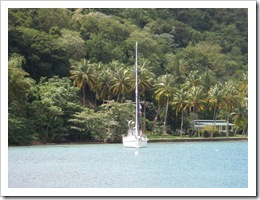 Chris: Easiest question- cruising-as-travel. I first got the idea of buying a boat after visiting a marina a little before Christmas and seeing the live-aboard community close up. I have had the boat for 13 years now, lived aboard until a year ago, and actively cruised four years. I still could take or leave the actual sailing most days. I love being able to take my whole home from place to place at my whim though.
Chris: Easiest question- cruising-as-travel. I first got the idea of buying a boat after visiting a marina a little before Christmas and seeing the live-aboard community close up. I have had the boat for 13 years now, lived aboard until a year ago, and actively cruised four years. I still could take or leave the actual sailing most days. I love being able to take my whole home from place to place at my whim though.Barbara: We were more attracted to the cruising life style and not sailing purists. We had no problems running the engine to get from A to B before dark.
What are some of your favorite pieces of gear on your boat and why?
Chris: Furling sails - makes it easy to single hand and good as your physical strength lessens with age. Stout auto-pilot. A wheel-drive auto-pilot doesn't belong on an offshore boat no matter what the manufacturer tells you. Great custom davits/arch - dinghy can be raised or lowered with one person, engine hoist, place for antennas, solar panels, wind generator. Biggest RIB-type dinghy you can carry, with largest motor it can carry. It's your car out there. Engle freezer. Low electrical draw and make having a freezer easy.
Barbara: We bought a soda machine our second year out and it was probably one of the best purchases. We stocked spare CO2 canisters and syrup. They pretty much lasted 3 years. Just before we left the boat we found (through other cruisers) that there is now a place in St. Martin that will refill the CO2 canisters.
What question do you wish I would have asked you besides the ones I've asked you and how would you answer it?
Chris: Firearms onboard? - Not worth the hassle in the US and Caribbean. You have to either lie about it or surrender it in most places. The risk of needing one is no worth the hassle of having one. Pets aboard? - Wonderfully fun (assuming you are a pet lover in the first place). But, they add another level of complexity to checking in and out of some countries, you have to deal with their needs, whether that is a litter box or daily walks ashore, getting proper food and supplies in the islands can be challenging, vet availability is limited, and traveling home is more complex and expensive.
Barbara: How often did you see or keep in touch with family? We were lucky that when we were in the US keeping in touch was easy, especially while we were in the Northeast. While in the Caribbean, you would be surprised at how readily available the internet has become. Using Skype you can call home and talk pretty much whenever you wanted and it was cheap. As far as visiting family, we only had 1 visitor in 4 years and I only flew back to the US once in the 2 years were in the Eastern Caribbean. We kept a website up to date and posted quite often, so most of our family kept up on where we were through that too.

